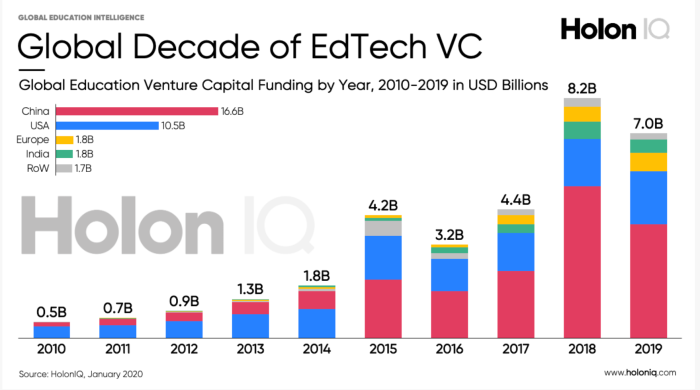
“Pst! Hey, Kid! Come here!”
Educational technologies are a multi-billion dollar industry.
“Who? Me?”
The coronavirus pandemic has closed schools across the globe, and districts have tried to solve this problem by putting their classes online.
“Yeah, you. I’ve got some… candy I want to give you.”
Nearly every ed tech company has offered help with this processes.
“Oh boy! I sure love candy… Wait a minute! How much does it cost?”
Teachers, parents, students and education activists are wary of educational technologies in the classroom, and research backs them up. Ed tech has been shown to widen socioeconomic divides, it hasn’t lived up to its promise of increasing academic gains, and – perhaps most tellingly – Silicon Valley executives restrict their own children’s use of technology and send them to tech-free schools.
“Nothing. It’s free.”
These for-profit corporations are offering limited time promotions – they’re providing additional services for free that would normally be behind a paywall.
“Oh goodie!”
Districts are jumping at the chance. They’re encouraging teachers to use apps, services and software that have never been tried before locally in an attempt to abide by continuity of education guidelines written by departments of education.
“That’s right. Absolutely free. But if you want some more, next time I’ll have to charge you a little something…”
So when the pandemic is over and classes eventually are reopened, a great deal of the technology that schools used to get through the crisis will no longer be on the house.
Continuing to use them will require an additional fee, and if districts end up budgeting for them, the money has to come from somewhere. So that means fewer books, field trips, tutors, classroom aides, and – yes – teachers.
In short, well-meaning governors, law-makers, administrators, school directors and even educators are participating in a program that in the long run may enrich private corporations but not be in the best interests of the students we’re supposed to serve.
I bring this up not to stop schools from using online learning during the crisis. Unfortunately that ship has sailed. Nor do I voice my objections to criticize teachers, parents or students. We all have to do what needs to be done to get through all this.
However, it is vital that we are aware of the compromises being made today so as to better avoid the pitfalls ahead.
When teachers use Zoom, Google Classroom, or any of dozens of other ed tech products during this season of social distancing, we must be aware that these should only be temporary measures. Do not resign yourself to any of this becoming the new status quo.
When classes resume, we can’t simply go back to normal. Nothing can ever be normal again. Normal is what got us into this mess – a society ill equipped to meet this pandemic – ill equipped to take care of its citizens, provide basic resources, equity and put people before profits.
The post coronavirus world must be one of universal healthcare, a social safety net for all and a robust, fully funded system of public education. We cannot allow it to be a dystopian world of edu-tech vulture capitalism where the economics of street corner drug pushers is used to dictate how public money is spent.
There are many clear reasons why.
First, education technologies are almost completely unregulated. Cybersecurity and student privacy laws are woefully out of date if not entirely nonexistent.
These applications collect a torrent of data on students. So do teachers, in fact, to calculate grades. However, if an educator were to share this information with outsiders, she could be sued. But if a corporation did the same thing, it falls into a legal no man’s land.
Each state has different laws denoting the limits of privacy.
The main federal law safeguarding student data privacy, the Family Educational Rights and Privacy Act (FERPA), was written in 1974 before much of these technologies even existed. It hasn’t been significantly amended since 2001.
So it’s left to individual districts, administrators, school boards and teachers to navigate these murky waters.
They end up trying to decipher the individual terms of service agreements and privacy statements with these companies that are often full of legal loopholes. In many cases, decision makers don’t even bother or give the job to school lawyers unversed in cybersecurity concerns or law.
While Congress has neglected its duty to regulate the industry, the matter is important enough that the Federal Bureau of Investigations (FBI) put out a strong warning. Two years ago, the Bureau cautioned consumers about the risks of classroom management tools like Class Dojo as well as student testing and remediation applications like Classroom Diagnostic Tools and Study Island.
The FBI warned schools and parents that widespread collection of student data involved in these applications could cause safety concerns if the information is compromised or exploited.
The Bureau was concerned about ed tech services because many are “adaptive, personalized learning experiences” or “administrative platforms for tracking academics, disciplinary issues, student information systems, and classroom management programs.”
And these are many of the same applications being used today for distance learning initiatives.
Education advocates have been sounding the alarm for years.
Commonsense.org – a nonprofit studying education issues – conducted a three-year review of 100 ed tech companies. It concluded that 74% of these businesses hold the right to transfer any personal information they collect if the company is acquired, merged, or files for bankruptcy. And since many are start-ups, this often happens.
The authors wrote that there is “a widespread lack of transparency, as well as inconsistent privacy and security practices” in how student information is collected, used, and disclosed.
Leaking student data is often not a security failure. It’s part of a company’s business model.
This is valuable information about one of the most lucrative demographics in the marketplace. Companies use it to help sell products targeted directly to consumers. And they can even sell student data as a commodity, itself.
For instance, imagine how much more effective the hiring process would be if businesses had access to applicants school attendance records. Imagine if businesses had an applicant’s entire academic record.
Employers could buy vast amounts of data and use algorithms to sort through it looking for red flags without fully comprehending what was being compiled. Imagine an applicant being turned down for a job because of low middle school attendance but not being able to explain that this was due to a legitimate illness.
There are reasons we protect people’s privacy. You shouldn’t have to explain your score on a 1st grade spelling test the rest of your life or have the need for special education services damage your credit rating.
Yet all of these things are possible when student data is up for grabs.
No one is protecting our children from this kind of mercantile future – one which will only be exacerbated if we allow educational technologies to become common place after the current crisis.
And tightening our student privacy laws, will not solve everything.
Hardly any attention is being paid to how these technologies can be used for harms unrelated to business and industry.
Tablets, laptops or monitoring devices such as cameras or microphones could be exploitable by tech savvy criminals – especially since many ed tech programs allow remote-access capabilities without the user even being aware of what is happening.
Pedophiles could use this data to find and abduct children. Criminals could use it to blackmail them. Other children could use it to bully and harass classmates.
It’s hard to imagine how children could be protected on such devices without increasing surveillance and thereby running similar risks. Using them will always involve a chance of endangerment so they should be kept away from the youngest and most vulnerable potential users.
How did we let ed tech get so out of control? Like so many problems of the pre-coronavirus world, money was allowed to dictate policy.

Global venture capital investments in ed tech finished 14 times higher by the end of the decade than they started. Investments went from $500 million in 2010 to $7 billion in 2019. And insiders expect that to triple in the next decade to more than $87 billion.
The two biggest spenders by far are China and the US.
Yet enthusiasm for such technologies are not nearly as prevalent among educators.
A 2019 study of educator confidence in ed tech conducted by Houghton Mifflin Harcourt found that 60% of teachers were concerned that implementing technology tools could damage the student-teacher relationship.
Moreover, education research in the United States concluded these technologies only widen the gap between different socioeconomic groups. Global initiatives like the One Laptop per Child program, which distributed 25 million low-cost computers with learning software to children in the developing world, failed to improve language or math results.
Meanwhile, students seem to be telling us they prefer more old school methods of instruction. Studies have shown preference for everything from physical books over eBooks to having “ordinary, real-life lessons” and “a smart person at the front of the room.”
Parent Blogger Alison McDowell has studied these issues in more depth than nearly anyone else. She warns that adaptive applications become the gatekeeper of children’s educations. They only allow students to move on once they’ve demonstrated mastery on a previous academic standard – or at least once they’ve been able to guess which one answer a programmer thought correct:
“The “personalized learning” model conditions students to view themselves as independent operators, free agents attempting to navigate a precarious gig economy alone. Screen-based isolation and an emphasis on data-driven metrics steadily erode children’s innate tendencies to creative cooperation. Which is ultimately better for society, an algorithm that learns each student in a classroom and delivers a pre-determined reading selection that they review and are quizzed on online, or a human teacher who selects an all class reading in which there is lively debate? The first scenario forecloses creative thought in service of data generation and reinforces there is but one correct answer. The second opens up chances for students to gain new insights while limiting opportunities for digital surveillance.”
Ed tech may allow us to stumble forward during the coronavirus quarantine, but it is not a central part of a healthy education system.
I’d like to see a new education system built from the ashes of the old where every child has the chance to learn, a system that forgoes standardized testing and corporate-written academic standards for individualization and human interaction. I’d like to see a world where charter and voucher schools are things of the past, where schools are integrated and differences valued, where teachers and learning are respected and esteemed.
That is not an ed tech centered world. It is a student centered one.
It is a world where our priorities are such that even the promise of the new and the free won’t encourage us to indulge in practices that put our children in greater danger.
It is a place where the pusher has no power because his product is seen for what it is – treacherous and unnecessary.
Like this post? You might want to consider becoming a Patreon subscriber. This helps me continue to keep the blog going and get on with this difficult and challenging work.
Plus you get subscriber only extras!
Just CLICK HERE.

I’ve also written a book, “Gadfly on the Wall: A Public School Teacher Speaks Out on Racism and Reform,” now available from Garn Press. Ten percent of the proceeds go to the Badass Teachers Association. Check it out!

